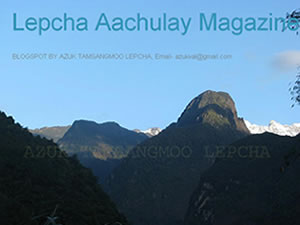Erudite and scholarly, yet charming and fun, the online publication Lepcha Aachulay Magazine provides a wonderful voice for an ancient culture and a still peaceful society.
 On April 1, the magazine posted three folksongs. The third, “Who Says the Lepchas Are Vanishing,” is especially enjoyable. “The beloved children of Nazanognyoo,” it begins, “the able and gifted children of Fadaongthing, originated from the laps of Creator, who says the Lepchas are vanishing?” Accompanied by a violin-like instrument, a chorus of five people sing, in Lepcha, a song extolling the permanence of their culture and society.
On April 1, the magazine posted three folksongs. The third, “Who Says the Lepchas Are Vanishing,” is especially enjoyable. “The beloved children of Nazanognyoo,” it begins, “the able and gifted children of Fadaongthing, originated from the laps of Creator, who says the Lepchas are vanishing?” Accompanied by a violin-like instrument, a chorus of five people sing, in Lepcha, a song extolling the permanence of their culture and society.
“The Rivers Teesta and Rangeet are still alive and running,” the YouTube performance continues. It urges the Lepchas to stand up—so that their historic king, Gaeboo Aachok, “did not die in vain from the Bhutanese swords.” Black clouds “are gathering on four sides,” the singers intone, with an effective English translation provided. An attractive young woman pantomimes with fluid motions the Lepcha words.
But the song does not urge the Lepcha to rearm or even to resist the domination of their land caused by invasions of various other peoples over the centuries. Instead, it repeats the opening stanza, that they originated from the laps of Creator. They may be a small minority in their country now, but they still have pride in their ancient culture.
The second song, a humorous number called “Song of the Porcupine,” focuses on a human being dressed as the title animal, dancing and prancing in an outdoor setting on four hands and feet. A chorus singing the porcupine’s song accompanies the grainy footage of the dancer, with both Lepcha and English wording provided. The subject of the song, the King of the Porcupines, roams high and low over hill and dale, eating various foods, going in and out of its burrow, enjoying life.
Published by Azuk Tamsangmoo Lepcha, older postings to the magazine in March include a rich display of cultural articles and interesting information. A 1,500 word piece dated March 31, “Who Are the Lepchas,” provides a brief history of the Lepcha people. Much of it is valuable to an outsider. Lyangsong Tamsang, the author, describes the origin of the Lepcha, the earliest inhabitants of the region of South Asia centered on Sikkim but including, originally, parts of Nepal, Bhutan, and West Bengal.
“Lepcha” is a corruption of a Nepalese term for the indigenous inhabitants of the region, anglicized by the British into its current form. They originally called themselves “Mutanchi Rong Kup Rum Kup,” which means “Beloved Children of Mother Nature and God” in the Lepcha language, and they still refer to themselves as “Mutanchi” or as “Rongkup” rather than as “Lepchas.”
They are still mostly nature worshippers. The author indicates that Joseph Dalton Hooker, the famous nineteenth century British botanist and explorer, in his book Himalayan Journals, complimented the Lepchas as outstanding botanists and naturalists. They have, in the opinion of Lyangsong Tamsang, an “intimate knowledge of all flora and fauna found in the Darjeeling, Sikkim, and Illam hills.” The history describes how the original Rongkup people were subjected by the Tibetans, now called Bhutias, then by Nepalese, and finally by the British.
“Nye Mâyel Kyong, a Paradise on Earth,” the previous post in the magazine dated March 29, provides the story of a Lepcha myth about a holy, eternal paradise village in which immortal human beings live. One day an original Lepcha man follows a wild boar into the hidden village. It turns out to be a tame pig, but the village people, seven elderly couples, welcome him with gracious hospitality and invite him to stay overnight.
When he leaves in the morning, the seven pairs of children who send him off—they become youths by mid-day—then disappear into the mountains. The annual Sakyoo Rum Fat harvest festival each year celebrates those seven Lepcha couples who gave them fruit, vegetable, and cereal seeds to plant.
Earlier posts in March include a gallery of photos of Lepcha people and a scholarly, descriptive bibliographical article about Lepchas manuscripts and books, their history and locations. The earliest article in the month briefly describes the rhythmic tones used in reading Lepcha manuscripts.
The magazine is worth careful study for its effective balance of probing scholarship and interesting popular material.